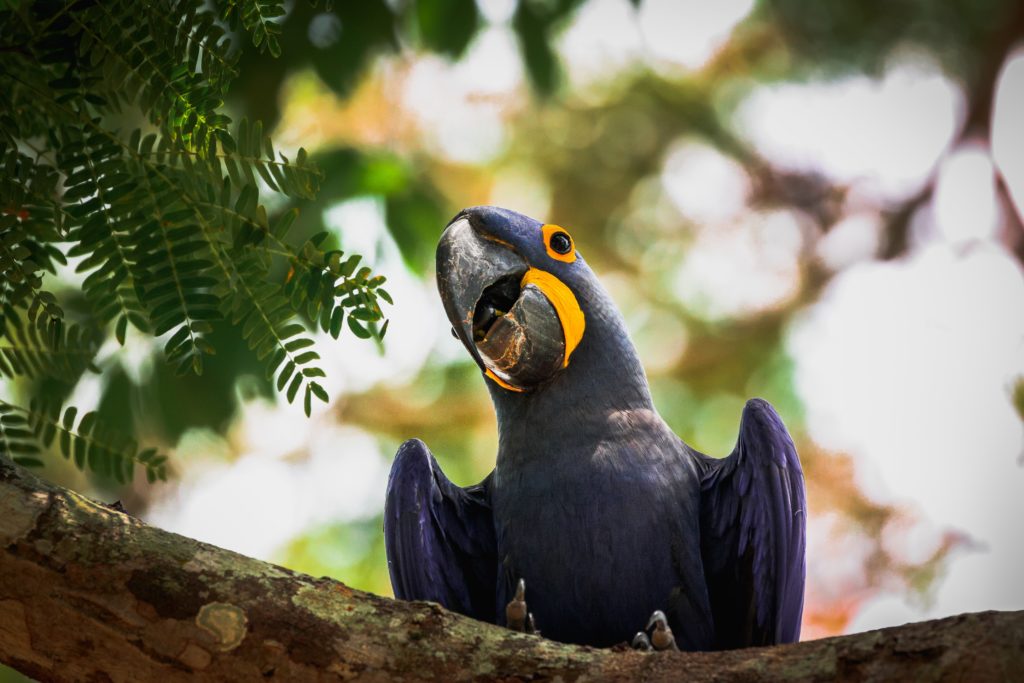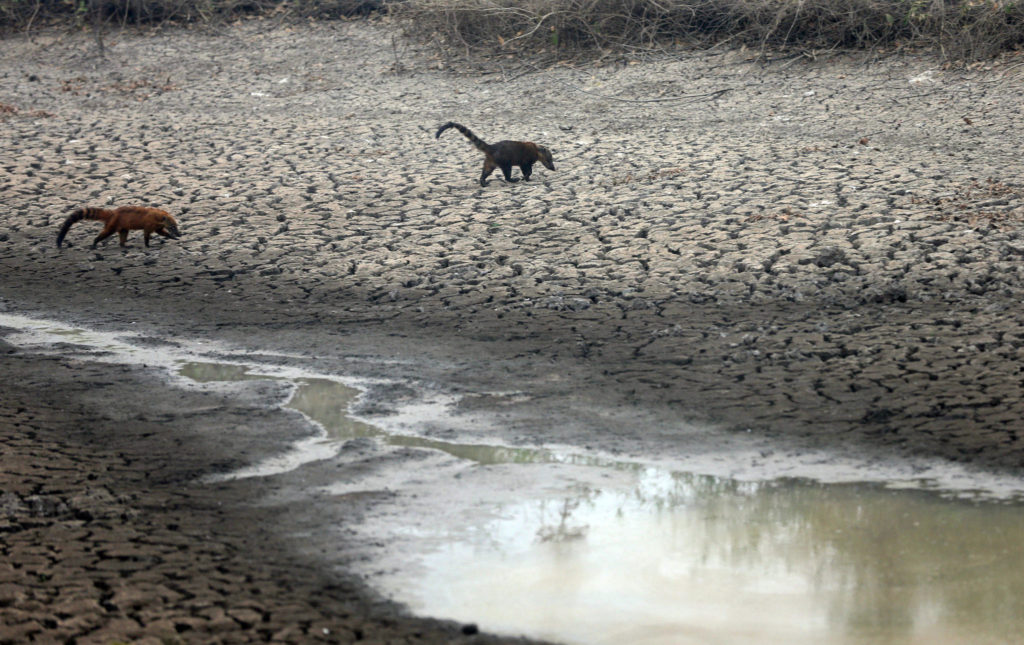A mosaic of lagoons, lakes, marshes, rivers, grasslands, and savanna and forest formations, the Pantanal is one of Earth’s most peculiar biomes. Boasting 20 times the size of the Everglades and spanning over 70,000 square miles across Brazil (62%), Bolivia (20%), and Paraguay (18%), it is the world’s largest floodplain.
As water flows and recedes across the year, the ecosystem pulsates. Between November and March, torrential rains drench the Pantanal. The water levels rise and rivers overflow, inundating 80% of the region. Sandy hills, green islands, and big trees punctuate the mirror-like landscape. In the dry period, from April to September, the water gradually drains away into the Paraguay River. Several pools containing fish and snails remain nonetheless filled in this period, attracting massive flocks of storks, spoonbills, and egrets.
Because much of the land continuously transitions between terrestrial and aquatic habitats, complex interactions among water, soils, topography, and plant and animal communities mark the Pantanal. These interactions make the biome a highly productive system, which hosts a great number and a high concentration of species. While many imagine the Amazon holds this position, the Pantanal has the highest concentration of wildlife on the neotropics.
The latest studies on biodiversity in the region have found 271 species of fish, 57 amphibians, 131 reptiles, 580 birds, and 174 mammal species. Many species that are endangered or unusual elsewhere—such as jaguars, tapirs, giant river otters, giant armadillos, marsh deer, blue hyacinth macaws, and the jabiru stork (the symbol of the biome)—are abundant in the Pantanal. Herons, parrots, parakeets, toucans, falcons, and thousands of species of butterflies also color the landscape, as well as 180 species of migratory birds. Ocelots, Howler and Capuchin monkeys, cougars, anteaters, capybaras, coatis, caimans, and green anacondas make their home in the biome. Because water is abundant, there are more fish species in the Pantanal than in all rivers of Europe, including the world-famous piranha.

To protect this exuberance, the United Nations Educational, Scientific and Cultural Organization (UNESCO) designated the Pantanal a Biosphere Reserve and World Heritage Site. Currently, more than 84% of the biome is protected. However, due to its strategic geographic location—and because less than 5% of the region is formally protected—the Pantanal is vulnerable to threats. Infrastructure projects—such as dams and waterways—and agribusiness operations have been increasingly pressuring the biome. In 2020, anthropic activities contributed to igniting the worst fire outbreak ever recorded in the region.
Natural fires are common in the dry areas of Pantanal and play an important part in the ecosystem. Given its proximity to the Cerrado, the vegetation in the biome has co-evolved with fire. Many plants have developed thick barks and hard shells to cover their seeds; these species require heat to germinate. Under normal circumstances, the bodies of water prevent wildfires from spreading, and they run out of fuel rapidly.
In 2020, however, the Pantanal faced the worst drought since 1973. Deforestation and fires ravaging the Amazon in 2019 and 2020 disrupted the dynamics of flying rivers, which regulate rainfall in the Pantanal. The reduction of hot and humid air transport from the Amazon to the region limited the rainfall. Much of the vegetation scorched, and areas that were supposed to be flooded remained dry.
Concomitantly, cattle farmers illegally set fire to forests. According to local communities, newcomers—who have a poor understanding of how to use fire sustainably—were most likely responsible for leading the illegal activity. Due to the unusually dry conditions, misconduct in the opening of areas for grazing, poor law enforcement, and lack of funding for fire prevention, the fires got out of control.
Almost 30% of the Pantanal burned last year. The fires destroyed roughly 83% of the Encontro das Águas State Park, a protected area where many endangered animals seek refuge. The fires also devastated five Indigenous territories; in three of those territories, 80% of the land burned. The extent to which the fires have damaged the local wildlife is still under study. Scientists have estimated that 65 million vertebrates and 4 billion invertebrates have been affected. These numbers include animals that lost either their habitats or lives, as well as those severely wounded.
Some large mammals and birds fled the fires, while many small mammals, amphibians, and reptiles could not escape. Unlike in places like California, small animals cannot seek refuge underground in the Pantanal, as these areas also burn. Moreover, engulfing 3.8 million hectares, the fires destroyed flowering plants and trees that feed pollinators and other animals, unleashing a cascade effect of starvation.

After the 2020 fire season, endangered coatis perambulated in a dry landscape in the Pantanal.
The fires jeopardize the resilience of the Pantanal and disrupt the services it provides. The wetlands purify water, regulate the water cycle, prevent floods and droughts, and are effective carbon sinks. As the biome burns, it contributes to climate change. In turn, climate change will further aggravate the susceptibility of the biome to fires. A recent study has projected that global changes will make the region hotter and drier each year, which could radically transform the ecosystem.
Prognoses for the fire season this year are concerning. The drought is harsher than that recorded in 2020. Amid fears that the Brazilian government will not enforce environmental laws, civil society has started a call for action across different sectors. Last year, tourists, scientists, veterinarians, non-governmental organization (NGO) members, and local communities aided the fire brigade operating in the area. In the coming years, the people and organizations fighting to protect the Pantanal will continue to require assistance. From local to global scales, there are many ways for citizens to help.
Global action targeting reduced greenhouse gas emissions and decreased deforestation are fundamental in protecting the Pantanal. Increased research on the biome and the social-ecological interactions that shape sustainability are also welcome. A boost in the ecotourism industry in post-pandemic times will also be of great value to ecosystem health. Besides stimulating conservation, tourists generate revenues that can finance sustainable management systems. Supporting—financially or via volunteering—the NGOs taking care of the local wildlife is another noble way to care for the biome, preventing its colors and sounds from fading. Hopefully, past mistakes will not disrupt the Pantanal to the same extent again, but animal and nature lovers must remain attentive to what happens in this biodiversity haven.
Also by Natalia: Is Digital Fashion The Next Step In Sustainable Fashion?
Get more like this—Sign up for our daily inspirational newsletter for exclusive content!
__
Photo: David Waite via Unsplash; WWF Brasil




